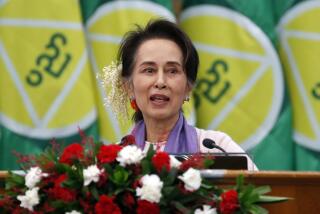The Lady would not be broken
- Share via
Reporting from Seoul — For years in her native Myanmar, Aung San Suu Kyi has been known simply as The Lady.
Although the pro-democracy stalwart and Nobel laureate has languished for years in confinement, residents have always known this about Suu Kyi: She would not be broken by the regime she has long defied.
The slight 65-year-old activist proved them right Saturday as she was freed from an imprisonment that had stolen 15 of her last 21 years.
Whether detained or not, supporters say, she has remained a quiet but determined symbol of struggle against political repression in the impoverished Southeast Asian nation, also known as Burma.
The daughter of a national hero who generations earlier had campaigned for Burma’s independence from Britain, she faced intense personal hardship to uphold her political principles, sometimes going years without seeing her husband or sons.
But as popes, presidents and activists called unsuccessfully for her release, she never wavered. Once asked whether she thought her story had the makings of a Greek tragedy, she responded: “Don’t be silly. I don’t go in for melodrama.”
She later said, “I look upon myself as a politician. That’s not a dirty word, you know. Some people think that there is something wrong with politicians. Of course, there is something wrong with some politicians.”
Time and again, Suu Kyi has showed her mettle since taking up the democracy struggle in 1988.
Spending much of her early life abroad, she returned home that year just as street protests erupted against a quarter of a century of military rule. She quickly assumed a leadership role, campaigning for the government to stage proper elections and becoming the first general secretary of the fledgling National League for Democracy.
In 1990, the party won 82% of the seats in national assembly elections, but the military government refused to hand over power.
Explaining why she risked prison or worse by taking on the nation’s military, she responded, “I could not, as my father’s daughter, remain indifferent to all that was going on.”
Her efforts to stop the brutal military suppression that killed thousands of protesters in 1988, repeatedly facing soldiers, gained her worldwide fame. In 1991 she was awarded the Nobel Peace Prize, being proclaimed by the Nobel committee as “an outstanding example of the power of the powerless.”
But Suu Kyi’s sons, Alexander and Kim, accepted the award in Oslo on behalf of their mother, who was detained in 1989 on national security charges.
She spent the next six years under house arrest at the family home at 54 University Ave., and has faced various periods in detention since then. Over the years, she has waged a number of hunger strikes.
But Suu Kyi endured. When her husband, British scholar Michael Aris, was dying in London in 1999, the regime wouldn’t let him enter the country, hoping that she would leave to see him. She refused, knowing that she would not be allowed to return.
They had seen each other only a few times since her first house arrest a decade earlier.
News reports have painted her life in captivity as austere. Rising each day at 4 a.m., she meditated, read and listened to one of five radios that were her only link to the outside world. She had no telephone, no television, no Internet. Her mail, if delivered at all, was heavily censored.
She was once an accomplished pianist, but Myanmar’s muggy heat long ago warped her instrument. Her only companionship was that of two long-serving assistants, a mother and daughter.
Recent months have brought particular frustration. Suu Kyi was just a few weeks away from being released last year when she received an unexpected visit by an American intruder, John Yettaw. She was found guilty of harboring anti-government elements and her sentence was extended.
At the time one of her assistants told reporters, “It has been a hard life, she has sacrificed a lot. But she is used [to it] now. And she keeps working, waiting for the day she will be released.”
More to Read
Sign up for Essential California
The most important California stories and recommendations in your inbox every morning.
You may occasionally receive promotional content from the Los Angeles Times.














